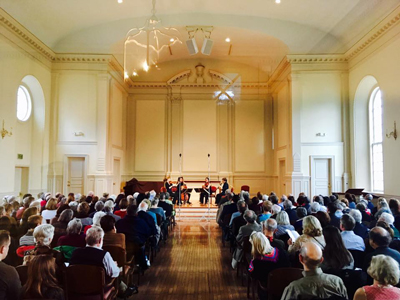by Daniel Hathaway

Separated from his lover by the Hellespont, Leander braved the waves to swim across the strait every evening to visit Hero. In a solo cantata, Clérambault tells of the eventful night when — unmoved by Hero’s plea for gentle winds and calm waves — Boreas, god of the north wind, kicked up a frightful storm and Leander drowned, followed by Hero, who dove into the waves herself. Neptune took pity and rewarded the couple with immortality. Rottsolk rivetingly narrated the tale in her clear, commanding voice.
McStoots took over for Clérambault’s Pirame et Tisbe, the prototype for the story of Romeo and Juliet (as well as the rude mechanicals’ daft play-within-a-play in Shakespeare’s A Midsummer Night’s Dream). Defying their quarreling families, the lovers arrange to meet — but a raging lioness (fiercely portrayed by gambist Emily Walhout) surprises Thisbe. She escapes, leaving her scarf behind. Pyramus finds it, and assuming the worst, takes his own life, inspiring Thisbe to do the same.
Singing warmly and effortlessly in all ranges, McStoots was particularly impressive in Pyramus’s “Plainte,” accompanied by Debra Nagy (recorder) and Julie Andrijeski (violin).
The story of the third ill-fated couple, Hippolyte and Aricie, took Jean-Philippe Rameau a whole, five-act opera to relate — he got somewhat distracted by a secondary plot. Artistic director Debra Nagy excerpted portions of the fourth and fifth acts, just enough of Rameau’s colorful, evocative music to give Rottsolk and McStoots ample opportunity to narrate the story both in solos and duets. They also added a bit of stage business, interacting just as sweetly as they sang. Andrijeski and violinist Even Few joined Nagy, Walhout, and harpsichordist Michael Sponseller in simulating a whole opera orchestra.
Two instrumental works rounded out the program. Jean-Féry Rebel’s trio sonata “L’Imortelle” was chock full of expressive suspensions sensitively played by Nagy, Andrijeski, Walhout, and Sponseller, who realized the keyboard continuo with fine French baroque flourishes. And Jean-Baptiste Senaillé’s Sonata, Op. 1, No. 6, provided a fine showcase for Andrijeski’s stylish violin playing.
Debra Nagy’s deft programming and Les Délices’ flawless but laid-back execution make music of the French Baroque instantly accessible to modern audiences. People who know something about the period will never feel talked down to, and neophytes have nothing to fear.
Photo from an earlier performance in Herr Chapel.
Published on ClevelandClassical.com April 17, 2017.
Click here for a printable copy of this article



